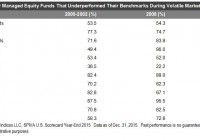Riskier Bond ETFs For A More Dovish Fed Outlook
By Max Chen and Tom Lydon With the Federal Reserve holding interest rates and only anticipating two rate hikes this year, fixed-income investors may turn to riskier debt securities and related exchange traded funds, reports industry analyst ETF Trends . The Fed’s dovish stance sent the U.S. dollar retreating, with the Dollar Index down about 1.9% since the Fed’s Wednesday announcement. “Any weakening of the U.S. dollar will support emerging markets that have issued U.S. denominated debt and will take pressure off of China’s need to manage their currency,” Matthew Whitbread, investment manager at Baring Asset Management, said on CNBC . “This would bode well for investors able to allocate to select emerging market currencies and local bond markets.” Fixed-income investors may gain exposure to U.S. dollar-denominated emerging market debt through ETF options. For instance, the iShares J.P. Morgan USD Emerging Markets Bond ETF (NYSEARCA: EMB ) has a 7.01 year duration and a 5.30% 30-day SEC yield. The PowerShares Emerging Markets Sovereign Debt Portfolio (NYSEARCA: PCY ) has a 8.34 year duration and a 5.90% 30-day SEC yield. The Vanguard Emerging Markets Government Bond ETF (NASDAQ: VWOB ) has a 6.2 year duration and a 4.95% 30-day SEC yield. Year-to-date, EMB rose 3.9%, PCY gained 3.6% and VWOB returned 3.4%. Additionally, with emerging market currencies appreciating against the greenback, local-currency emerging market bond ETFs have also been outperforming. For local currency-denominated emerging market bond ETFs, the iShares Emerging Markets Local Currency Bond ETF (NYSEARCA: LEMB ) has a 4.77 year duration and a 4.73% 30-day SEC yield. The Market Vectors Emerging Markets Local Currency Bond ETF (NYSEARCA: EMLC ) has a 4.76 year duration and a 5.95% 30-day SEC yield. The actively managed WisdomTree Emerging Markets Local Debt Fund (NYSEARCA: ELD ) has a 5.01 year duration and a 5.89% 30-day SEC yield. Year-to-date, LEMB increased 3.7%, EMLC advanced 6.6% and ELD gained 5.3%. “Overall, a more dovish Fed should support risky assets, in particular high yield credit that benefits both from falling yields as well as economic growth,” Whitbread added. For instance, over the past two days, the SPDR Barclays High Yield Bond ETF (NYSEARCA: JNK ) was up 1.7% and the iShares iBoxx $ High Yield Corporate Bond ETF (NYSEARCA: HYG ) was 1.2% higher. JNK has a 4.26 year duration and a 7.28% 30-day SEC yield. HYG has a 4.01 year duration and a 7.26% 30-day SEC yield. Disclosure: I/we have no positions in any stocks mentioned, and no plans to initiate any positions within the next 72 hours. I wrote this article myself, and it expresses my own opinions. I am not receiving compensation for it. I have no business relationship with any company whose stock is mentioned in this article.
